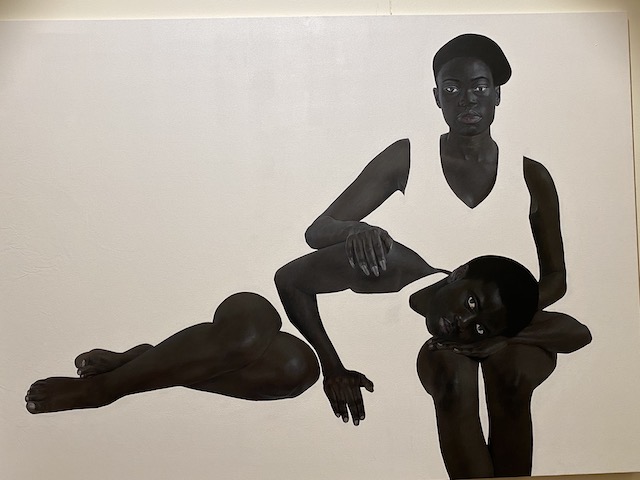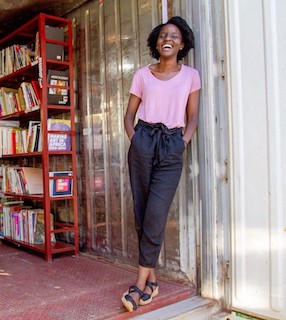Omusana Review is delighted to interview Teesa Bahana, the director of 32 Degrees East Ugandan Arts Trust. Bahana is one of the most inspiring voices in Uganda, leading a non-profit organization that champions the professional development of contemporary artists on the continent. Art’s role in bringing people together, championing the imagination, and promoting cultural preservation cannot be overstated. It is self-evident that a country’s cultural heritage and its economic sustainability require some investment in the arts. While the need for support is felt in many countries, it is urgent in Africa, where physical infrastructure—galleries, museums, and libraries are few. Since 2011, 32 Degrees East, headed by Bahana, has worked to fill this gap by championing contemporary artists. 32 Degrees East has produced initiatives such as KLA ART Festival (which is currently in its 4th edition). It has supported over 60 artists in its residency program. Also, 32 Degrees East has provided a Resource Center where critical conversations can take place. As Bahana noted, “we can’t change society without individuals having a transformative experience.” Art allows people to engage visually with events within their society and to have a communal experience.
In our interview, Bahana gives us insight into the contemporary art landscape in Uganda and the work of 32 Degrees East. We explore her journey into the arts, the incredible energy coming from Uganda, and the importance of visual storytelling as a vehicle to document and archive cultural heritage.
I want to start by exploring your journey into the art world; what was the genesis of your interest in Art?
Art was the one class that I wasn’t good at. I was good at memorizing things and figuring out the right way to answer questions, but art never had a right answer; it wasn’t anything that I could solve. As a pretty analytical person, it felt like one thing that I couldn’t puzzle through and it was more a way for me to spend time just feeling. I had this kind of awe of artists, that they were tapped into a realm that I couldn’t quite get to or experience, but also couldn’t understand. And the older I got and the less currency I put into being good at school, the more drawn I became to people who bucked convention and operated on different wavelengths.
Can you talk about 32 Degrees East— Its history, mission, and the current work it’s doing?
We are a contemporary art centre that was founded in 2011 in response to an art scene that was brimming with talent but had few physical spaces for artists to gather in community. It was created to be a place for process, where artists could experiment without the pressure of production, lead their own learning through a well-resourced library, and connect with new ideas through programming. Previous artists in residence have gone on to show at the Stellenbosch Triennale, have residencies at the Rijksakademie, win top prizes at the Absa L’atelier Awards, and open their own art centres.
Over recent years we have hosted over 65 artists in residence, facilitated international exchanges for 22 Ugandan artists, and engaged over 10,000 members of the public through KLA ART. This October, we host the fourth edition of KLA ART under the theme ‘This is Ours’ with 11 artists after over 2 years of collaborative work and study together.
We are also currently in a moment of exciting transition as we are beginning construction on our brand new home! This home will have world-class facilities for artists, including studios, libraries, and workshop space. It will also enable a greater reach through more public facing features like a cafe and gallery. These combined with also help generate income to allow us more independence and flexibility.
Uganda is becoming a formidable space for contemporary artists—there is incredible energy not just in Kampala but Entebbe, Jinja, and Fort Portal; who are some of the people (artists, gallerists) and organizations driving this incredible energy?

Sungi Mlengeya, Unclench, 2020. Afriart Gallery.
Well, I’ll start with Kampala because I know it best, and will also shout out all this year’s KLA ART artists because we’ve been working together for two years, and I think they are all amazing. It’s also been exciting to watch Sungi Mlengeya’s trajectory, and was glad to be introduced to Charlene Komuntale’s work through the Silhouette Residency space, which is doing a great job with spotlighting young artists. Ian Mwesiga, Stacey Gillian Abe, and Wasswa Donald are perennial favourites. I think Matt Kayem’s writing is also contributing a lot to our scene. Xenson Art Space as a new exhibition space. Outside of Kampala, I actually have to add Masaka to that list with Collin Sekajugo and Masaka Gallery. Then in Fort Portal, there’s Jabulani Arts Hub led by Sowedhi Uthman Kiwanuka. Then in Jinja, Nicole Remus and her team are doing cool things with the Creative Tribe.
In the article you published for the guardian, you hit on this idea that people don’t take artists seriously, even at the family level. What do you think underlies this attitude, and how do you change?
Well, in Uganda there are several factors. For example, just a few days ago, the president declared that art teachers should not receive salary increments this year; only science teachers should ‘because they directly contribute to societal advances and improved livelihoods, unlike Arts counterparts.’ That’s the context we are operating in. When the greatest authority in the country does not see how art contributes to societal advances, it’s an uphill climb for everything and everyone else. It can mean no investment in infrastructure for the arts, so you don’t grow up going to museums and don’t have the opportunity for interest in art to be cultivated at a young age. It can also mean no investment in the ecosystem that becomes a supportive environment for artists to create work and make a living. For over 30 years, there has been no large-scale investment in arts and culture, and artists from all disciplines often have to struggle for legitimacy, which definitely has an impact on how the average person views artists.
In our conversation earlier—we talked about visual storytelling as a critical part of documenting and archiving heritage. One of the projects that illustrate this is Bathsheba Okwenje’s Gang Kikome, where she photographs objects discarded during the war in Northern Uganda. How did you come up with this theme, and what has the response been to this incredible exhibition?
So Bathsheba’s work, Gang Kikome, [she] was one of three artists who were a part of our Politics of Return residency. Willy Karekezi from Rwanda and Gael Kusakusa Maski from DRC were also part of the programme, which was facilitated by Dr. Kara Blackmore. The residency was part of the larger Politics of Return research project from the London School of Economics under the Firoz Lalji Centre for Africa that explored the dynamics of return and reintegration of refugees in Central and Eastern Africa. The residency sought to build a bridge between the research and the lived experience of refugees, humanising their stories and bringing new empathetic dimensions to the research.
The response from what I saw was really fantastic, many of the participants in the interview not only saw their story in a new way but became collaborators in the making of the art. It was also a more impactful way for them to experience the research, as several people mentioned, often being asked questions from different researchers over the years and not knowing what happens with these interviews afterwards. Audiences not familiar with the research spoke of how stirring they found the work, and how it brought a vivid dimension to this important research, and also was a way to access research that would have otherwise been unavailable to them.
Lastly, in what ways can the audience support 32 Degree East?
We’re still in the middle of fundraising for construction, so any contribution would go a long way! Supporting us on social media through likes, shares, and follows is also always appreciated. And you can subscribe to our newsletter too!


